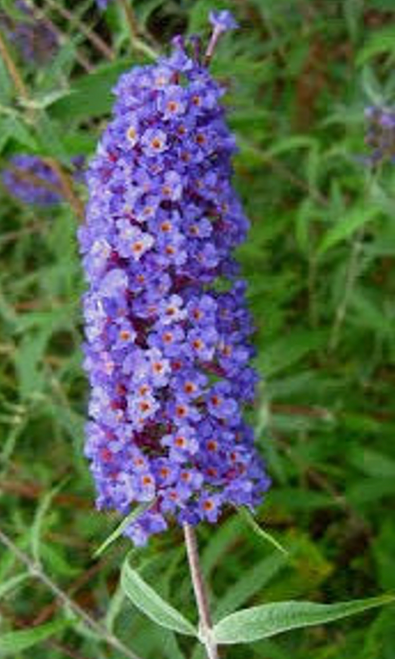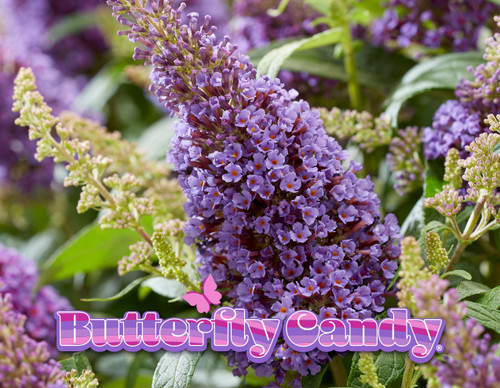Plant Highlights:
- Growing Zone: 5-10
- Flower Color: Yellow
- Bloom Time: Summer to fall
- Mature Height: 5-7' depending on pruning
- Mature Width: 5-7' depending on pruning
- Growth Rate: Fast
- Exposure: Sun, part shade
Additional Highlights:
- Pollinator Friendly: Yes
- Deer Resistant: Yes
- Pet Friendly: Yes
- Reblooming: Yes
- Cold and Heat Tolerant: Yes
The Buddleia x weyeriana 'Honeycomb,' commonly referred to as the Yellow Butterfly Bush, is a charming choice for any garden, flourishing in USDA hardiness zones 5 through 9. The vibrant gray-green leaves create an ideal setting for the vibrant yellow flowers, drawing in a variety of pollinators like butterflies and bees, making it a fantastic option for those looking to enhance their pollinator gardens. This plant has a height of 5-7' feet and a width of 5-7' feet unpruned, making it a beautiful centerpiece for borders or mixed flower beds. This shrub is also resistant to deer, making it a wonderful choice for gardens in regions where deer are prevalent. It's also safe for pets, giving pet owners reassurance.
General Planting Guide
In order to help those taking care of to their plants, this is our easy-to-follow guide that highlights several important steps:
Picking the Right Plants
Determine Your The environment:
Take into account the climate, sunlight availability, and soil characteristics of your gardening space. Check your growing zone to be sure the plant will perform correctly.
The purpose and Location
Identify your goals for your plants, such as providing shade, enhancing decoration, or controlling erosion, and consider the best locations in your garden for their growth.
Preparing the Soil
Testing Soil: Test the pH and nutrient levels of your soil to determine any necessary amendments.
Amending Soil: Incorporate compost, manure, or other organic materials to enhance soil fertility and structure.
In order to help those taking care of to their plants, I'll provide an easy-to-follow guide that highlights several important steps:
Planting
Schedule: It's best to plant when the weather is mild, usually in the spring or fall, based on the type of plant and the local climate.
Method: Excavate a hole that is twice the width of the root ball, ensuring it is not deeper. Set the plant into the hole and add soil, pressing down lightly as you proceed.
Irrigation
Initial Watering:Ensure you water deeply after planting to help the soil settle around the roots.
Regular Watering: Follow the unique water needs of each plant, making adjustments based on rainfall, temperature, and soil conditions.
Use our MOISTURE MAXX non-ionic wetting agent all year or during times of drought for extended help keeping your plants well hydrated for up to 40 days.
Mulching
Advantages: Using mulch is beneficial for keeping soil moist, controlling weeds, and maintaining a stable soil temperature. Place a 2-3 inch layer of organic mulch around the base of the plant, ensuring it does not touch the stems directly.
Fertilizing the Soil
Type of Fertilizer: Opt for a balanced fertilizer that matches the needs of the plants you are cultivating.
Purchase our slow release fertilizer SR-18-5-10 online for the same fertilzer we use in our soil mixes eveyday.
How often: Apply our fertilizer once through the growing season, usually in spring, taking into account the plant's development and the soil's nutrient levels.
Pruning
Goal: Pruning is essential for managing the size, shape, and overall health of plants, as it involves the removal of dead or diseased branches. Prune at the appropriate time for each type of plant, usually during their dormant period for most trees and shrubs.
Managing Pests and Diseases
Observing: Consistently check your plants for any indications of pests or illness. Employ a blend of cultural, physical, biological, and chemical strategies to effectively manage pests and diseases sustainably.
Seasonal Care
Spring: Get the beds ready, trim as needed, and start a consistent watering routine.
Summer: Keep an eye on watering requirements, manage pests, and remove spent flowers to promote fresh blossoms.
Autumn: Plant spring bulbs, apply mulch, and get plants ready for winter.
Winter: Safeguard your plants against freezing temperatures and consider pruning any dormant ones if necessary.
Gardeners at any level can create a thriving garden by following these generalized steps, which enhances their home environment and provides enjoyment throughout the year. If there are any specific plants you're working with or additional details you need, feel free to ask!
Ordering:
Our processing time usually is 1-3 days after receiving the order. Orders taken after 4:00 pm on Wednesday through Sunday will be shipped the following Monday.
Shipping:
The Plant Factory, Inc. offers the very best shipping processes to ensure quick, safe, and near-perfect results every time. Cold and heat may deter your order temporarily until it is safe to receive and plant your plants/trees in your area. At our discretion, we will hold order till the threat is gone ensuring you with the healthiest-viable product ordered.
Summer/Winter Shipping Restrictions - Above 95 degrees | Winter - Below 34 degrees
Note: We put pictures and videos on our site to best represent our products, as an example of our quality as a grower. You may, however receive a smaller or larger plant than pictured depending on the season you buy. You may or may not get a plant blooming as shown on our site. We usually trim off blooms because they do not ship well. Your purchase of our plants should be considered an investment in your future garden and enjoy the process of growing it to its full potential.
Why The Plant Factory, Inc is a good choice?
Our plants are grown at our nursery. Our experienced staff use the best horticultural practices to ensure our plants are of the utmost health and quality. We select your plants as if we were buying them ourselves. Our standard goals are to exceed our customers’ expectations. We pride ourselves for great “out of the box” experiences with hassle-free customer service and quick resolutions.








